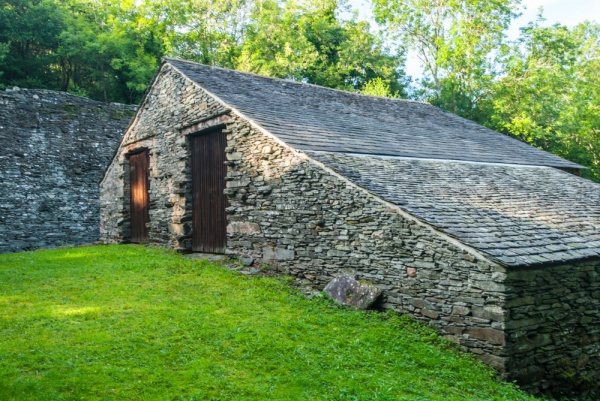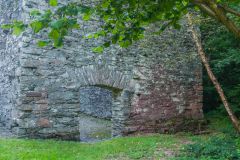
The Duddon Iron Furnace is a well-preserved 18th-century charcoal-fired iron furnace in a wooded setting at Duddon Bridge, in the south-west corner of the Lake District National Park. Locally mined iron ore was mixed with small amounts of limestone and smelted with charcoal to produce pig iron for transport and further processing elsewhere.
The Duddon site was perfect, for it had ready access to both charcoal and locally mined iron ore in the form of West Cumbrian hematite. The Furnace site lies immediately south of the River Duddon, at the southern end of woodland where charcoal could be cheaply produced. The industrial heritage of the site lives on, as the wood is still called Furnace Wood.
The Furnace used water from the River Duddon, brought by a leat which is still visible, to drive a set of bellows which forced air into a combustion chamber at the base of a furnace stack. The iron ore was smelted using locally manufactured charcoal for fuel.
History
In 1736 the Backbarrow Company joined forces with the Cunsey Company to open a charcoal-fired blast furnace at High Duddon, near Broughton-in-Furness. A few years later in 1741, the Backbarrow Company sold its shares in the venture to their Cunsey partners, who already operated furnaces at Cunsey, on the western side of Lake Windermere.
The Cunsey Furnace closed in 1750 but the company continued at Duddon Bridge, renaming itself the Duddon Company. After the deaths of several directors, the company was renamed yet again, as Jonathan Kendall & Co. In that guise, the company opened a new furnace near Inveraray, on the shore of Loch Fyne in Argyll.

The Duddon Iron Furnace shipped pig iron to Chepstow in South Wales and to Bristol. The pig iron was then used to make iron products for ships, such as chains and anchors. Operation continued until 1867.
The most impressive parts of the site are the furnace stack, which still stands to its full height of 29 feet, and the charcoal barn, which stretches 100 feet in length. The other intact part of the site is the iron ore store.
The Furnace was investigated in the 1980s but a full report was never published. There is a useful information panel beside the Furnace, telling the history of the site and showing an artist's impression of how it would have looked. It is now looked after by the Lake District National Park.
A single-span bridge leads to the charging platform, with changing rooms for workers beneath it. The furnace hearth has been removed.

Visiting
I discovered the Iron Furnace by complete accident. I was staying at the lovely Dower House bed and breakfast in Duddon Bridge, and I noticed an intriguing sign to the Furnace off the driveway to the bed and breakfast, which is located just a few hundred yards away.
I couldn't resist exploring and followed the path through the pleasant woodlands and emerged at the old furnace buildings, which were then in the process of being restored and opened to the public. What a delightful place to explore. Even if you don't fancy industrial heritage the location is beautiful and secluded, even though it lies just a short distance off the A595.
The Duddon site is one of the best surviving examples of a charcoal-fired iron furnace in England, and well worth a visit. Unfortunately, the site is not well signposted. At Duddon Bridge take the minor road towards Ulpha and Waberthwaite, and almost immediately you will see a turning on your left for Dower House. There is a layby for several cars and a short footpath to the Furnace site.
About Duddon Iron Furnace
Address: Duddon Bridge,
Broughton-in-Furness,
Cumbria,
England
Attraction Type: Historic Building
Location: Immediately off the A595 at Duddon Bridge, on the minor road to Ulpha.
Website: Duddon Iron Furnace
Location map
OS: SD196882
Photo Credit: David Ross and Britain Express
POPULAR POSTS
HERITAGE
 We've 'tagged' this attraction information to help you find related historic attractions and learn more about major time periods mentioned.
We've 'tagged' this attraction information to help you find related historic attractions and learn more about major time periods mentioned.
Find other attractions tagged with:
NEARBY HISTORIC ATTRACTIONS
Heritage Rated from 1- 5 (low to exceptional) on historic interest
Broughton-in-Furness, St Mary's Church - 1 miles (Historic Church) ![]()
Swinside Stone Circle - 1.3 miles (Prehistoric Site) ![]()
Ulpha, St John's Church - 3.1 miles (Historic Church) ![]()
Millom Discovery Centre - 5.2 miles (Museum) ![]()
Millom, St George's Church - 5.4 miles (Historic Church) ![]()
Blawith, St John's Church - 5.7 miles (Historic Church) ![]()
Stanley Ghyll Force Waterfall - 7.1 miles (Countryside) ![]()
Birks Bridge - 7.3 miles (Countryside) ![]()
Nearest Holiday Cottages to Duddon Iron Furnace:
Broughton-in-Furness, Cumbria
Sleeps: 6
Stay from: £426 - 2299
Broughton-in-Furness, Cumbria
Sleeps: 4
Stay from: £272 - 1431
Broughton-in-Furness, Cumbria
Sleeps: 8
Stay from: £602 - 2058
More self catering near Duddon Iron Furnace











